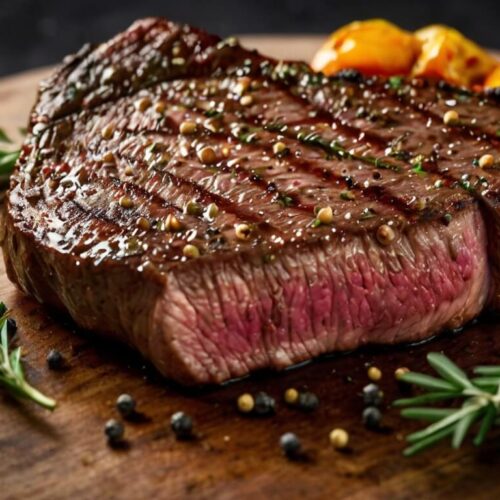William Howard Taft, the 27th President of the United States, is often remembered for his substantial physical presence and his role in shaping the judicial branch of the government.
As both president and later Chief Justice of the Supreme Court, Taft had a significant impact on American history. Alongside his professional achievements, Taft was known for his hearty appetite and love of good food.
One of his favorite dishes was peppercorn T-bone steak, a meal that perfectly captures his appreciation for robust, flavorful fare. In this blog post, we’ll explore Taft’s life, his presidency, and his connection to peppercorn T-bone steak. We’ll also share a recipe that allows you to enjoy this classic dish at home.
Early Life and Legal Career
William Howard Taft was born on September 15, 1857, in Cincinnati, Ohio, into a politically active family. His father, Alphonso Taft, served as Attorney General and Secretary of War under President Ulysses S. Grant.
Taft followed in his father’s footsteps, pursuing a legal career and eventually becoming a judge at a relatively young age. His reputation for fairness and competence led to his appointment as Solicitor General and later as a judge on the U.S. Court of Appeals for the Sixth Circuit.
The Presidency: Struggles and Achievements
Taft’s presidency, which lasted from 1909 to 1913, was marked by both successes and challenges. Although he was a reluctant candidate, Taft was handpicked by Theodore Roosevelt to succeed him.
However, Taft’s more conservative approach to governance soon led to a rift between him and Roosevelt, culminating in a split in the Republican Party.
Despite these political difficulties, Taft’s presidency saw significant achievements, including the strengthening of antitrust laws, the passage of the Mann-Elkins Act (which expanded the powers of the Interstate Commerce Commission), and the creation of the U.S. Postal Savings System.
Taft also played a key role in advancing civil service reform and promoting judicial appointments based on merit rather than political connections.
Legacy of William Howard Taft
After losing his bid for re-election in 1912, Taft’s legacy was cemented not through his presidency, but through his later role as Chief Justice of the United States, a position he held from 1921 to 1930.
As Chief Justice, Taft modernized the federal judiciary and strengthened the Supreme Court’s role as an independent branch of government. His dual legacy as both president and Chief Justice makes him a unique figure in American history.
William Howard Taft’s Favorite Food: Peppercorn T-Bone Steak
Peppercorn T-bone steak was one of William Howard Taft’s favorite dishes, reflecting his love for hearty and substantial meals. Known for his large appetite, Taft often indulged in rich, flavorful foods that satisfied his cravings for robust fare. The T-bone steak, with its combination of tenderloin and strip steak, was a perfect match for Taft’s tastes.
The addition of a peppercorn crust added an extra layer of bold flavor, creating a dish that was both simple and luxurious. Taft’s love for this steak underscores his appreciation for the finer things in life, particularly when it came to food. His enjoyment of such a rich and satisfying dish aligns with his larger-than-life persona and his reputation as a man who truly savored life’s pleasures.
Recipe for Peppercorn T-Bone Steak

Peppercorn T-Bone Steak
Ingredients
- 2 T-bone steaks about 1 to 1.5 inches thick
- 2 tablespoons black peppercorns coarsely crushed
- 1 tablespoon kosher salt
- 2 tablespoons olive oil
- 4 tablespoons unsalted butter
- 4 cloves garlic smashed
- 2 sprigs fresh rosemary
- 2 sprigs fresh thyme
Instructions
Preparing the Steaks:
- Remove the T-bone steaks from the refrigerator and let them come to room temperature for about 30 minutes. This helps the steaks cook more evenly.
- Pat the steaks dry with paper towels, then season both sides generously with kosher salt. Press the crushed peppercorns into both sides of the steaks to create a peppercorn crust.
Searing the Steaks:
- Heat a large cast-iron skillet over medium-high heat. Add the olive oil and let it heat until shimmering.
- Carefully place the steaks in the skillet and sear for 3-4 minutes on each side, or until a deep, golden-brown crust forms.
Basting with Butter:
- Reduce the heat to medium. Add the butter, garlic, rosemary, and thyme to the skillet.
- As the butter melts, tilt the skillet slightly and use a spoon to continuously baste the steaks with the melted butter and herb mixture. This adds rich flavor and helps keep the steaks moist.
Finishing the Steaks:
- Continue cooking the steaks, basting frequently, until they reach your desired level of doneness (about 130°F for medium-rare).
- Remove the steaks from the skillet and let them rest for 5-10 minutes before serving. This allows the juices to redistribute, ensuring a juicy, tender steak.
Serving:
- Serve the peppercorn T-bone steaks with your choice of sides, such as mashed potatoes, sautéed vegetables, or a crisp green salad. The rich, peppery flavor of the steak pairs well with a robust red wine, such as Cabernet Sauvignon or Merlot.
Video
Notes
- Customize the Heat: If you prefer a milder flavor, use a combination of black, white, and green peppercorns. For a spicier kick, increase the amount of black peppercorns or add a pinch of red pepper flakes to the crust.
- Grilling Option: For a smoky flavor, consider grilling the T-bone steaks instead of pan-searing them. Simply follow the same seasoning steps and cook the steaks over medium-high heat on the grill.
- Essential for Juiciness: Always let your steaks rest after cooking. This allows the juices to settle, making the meat more tender and flavorful when you cut into it.